Philip II of Spain facts for kids
Quick facts for kids Philip II |
|
|---|---|
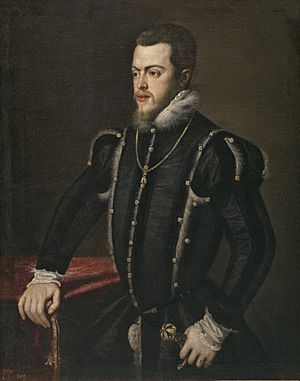
Portrait by Titian (1550)
|
|
| King of Spain (more…) | |
| Reign | 16 January 1556 – 13 September 1598 |
| Predecessor | Charles I |
| Successor | Philip III |
| King of Portugal (more…) | |
| Reign | 12 September 1580 – 13 September 1598 |
| Acclamation | 16 April 1581, Tomar |
| Predecessor | Henry or Anthony (disputed) |
| Successor | Philip III of Spain |
| King of England and Ireland (jure uxoris) | |
| Reign | 25 July 1554 – 17 November 1558 |
| Predecessor | Mary I |
| Successor | Elizabeth I |
| Co-monarch | Mary I |
| Born | 21 May 1527 Palacio de Pimentel, Valladolid, Castile |
| Died | 13 September 1598 (aged 71) El Escorial, San Lorenzo de El Escorial, Castile |
| Burial | El Escorial |
| Spouse |
|
| Issue Detail |
|
| House | Habsburg |
| Father | Charles V, Holy Roman Emperor |
| Mother | Isabella of Portugal |
| Religion | Roman Catholicism |
| Signature | |
Philip II (born May 21, 1527 – died September 13, 1598) was a very powerful king who ruled over a huge empire. He was known as Philip the Prudent. He became King of Spain in 1556 and King of Portugal in 1580. He also ruled Naples, Sicily, and was Duke of Milan. For a few years, he was even King of England and Ireland because he married Queen Mary I.
Philip inherited the vast Spanish Empire from his father, Emperor Charles V. During his time, Spain was at its strongest, a period often called the Spanish Golden Age. His empire stretched across many continents. He saw himself as a strong defender of the Catholic faith against the Ottoman Empire and the Protestant Reformation. He also completed the building of the royal palace, El Escorial.
Contents
Early Life and Education (1527–1544)
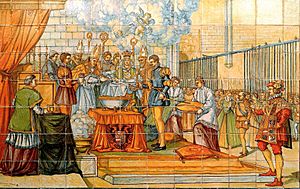
Philip was born in Valladolid, Castile, on May 21, 1527. His parents were Emperor Charles V and Isabella of Portugal. He was part of the powerful House of Habsburg.
He grew up in the royal court of Castile. His teachers helped him learn about arts and letters. He became good at Latin, Spanish, and Portuguese. However, he preferred Spanish culture and living in Spain. This made it harder for him to become Holy Roman Emperor like his father.
When Philip was just 11 months old, he was recognized as the future king of Castile. He was very close to his mother and his sisters, María and Juana. He also had loyal friends who served him throughout his life.
Philip learned about warfare from his governor, Juan de Zúñiga. He also got practical lessons from the Duke of Alba during the Italian Wars. In 1542, he was present at the Siege of Perpignan, where the Spanish army won.
In 1543, his father, Charles V, decided Philip was ready to rule. At just 16 years old, Philip became the regent of the Spanish kingdoms. He was also made the Duke of Milan in 1540. His father left him with experienced advisors and important instructions, telling him to be "pious, patient, modest, and distrustful." Philip grew up to be a serious and careful ruler.
Ruling Spain: Domestic Policies
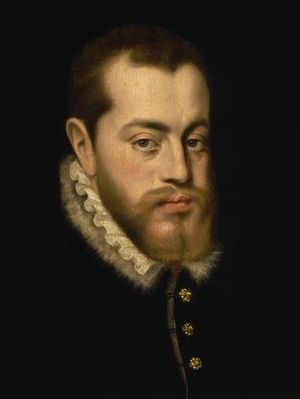
After living in the Netherlands for a while, Philip II decided to move his court back to Castile. He was a powerful king, but he still had to follow many laws and traditions. Spain was not one single kingdom but a group of separate areas. Each area had its own laws and rights. This meant Philip often found that local leaders had more power than he did in their regions.
Philip faced problems with the large Morisco population. These were people who had been forced to convert to Christianity. In 1569, the Morisco Revolt broke out in Granada. Philip ordered the Moriscos to be moved to other parts of Spain.
Even though Spain had a huge empire, its population was small. This meant less tax money for the king. Philip had trouble raising enough money for his military campaigns. He relied heavily on the wealth coming from the New World (the Americas). However, his government went bankrupt several times.
Despite these challenges, Spanish culture thrived during Philip's reign. This period is known as the "Spanish Golden Age." It produced amazing works in literature, music, and art. One famous artist was Sofonisba Anguissola, who painted many portraits of the royal family.
Economic Challenges
Philip inherited a lot of debt from his father. This led to Spain defaulting on its loans several times (in 1557, 1560, 1575, and 1596). This meant the government couldn't pay back its loans. These financial problems continued for many years after Philip's death.
Spain was made up of different kingdoms, each with its own assemblies and laws. This made it hard to rule efficiently. Philip had to be very involved in the details of government. He oversaw special councils for state affairs, money, war, and the Inquisition.
In 1561, Philip moved his court to Madrid, making it the new capital of Spain. He also turned the Royal Alcázar of Madrid into a royal palace. Philip worked tirelessly, even from his sickbed, at his palace-monastery, El Escorial. This grand building was finished in 1584 and showed Spain's importance in the Christian world.
Foreign Relations and Wars
Philip's foreign policy was shaped by his strong Catholic faith and his family's goals. He saw himself as the main protector of Catholic Europe. He fought against the Ottoman Empire and the spread of Protestantism. His constant wars put a huge strain on Spain's money.
Wars in Italy and France
Philip became King of Naples and Sicily in 1554. In 1556, he even invaded the Papal States for a short time. Spain fought the last part of the Italian Wars. Spanish forces won important battles at St. Quentin (1557) and Gravelines (1558) against France.
The Treaty of Cateau-Cambresis in 1559 ended these wars. It confirmed Spain's control over Milan, Naples, Sicily, and Sardinia. This made Spain the most powerful country in Europe.
Philip also got involved in the French Wars of Religion (1562–1598). These were civil wars between French Catholics and Protestants (Huguenots). Philip supported the Catholic side. He even sent his army into France to try and stop Henry IV from becoming king. However, Henry IV eventually converted to Catholicism, and the wars ended with the Peace of Vervins in 1598. Philip's efforts helped ensure Catholicism remained strong in France.
Fighting the Ottoman Empire
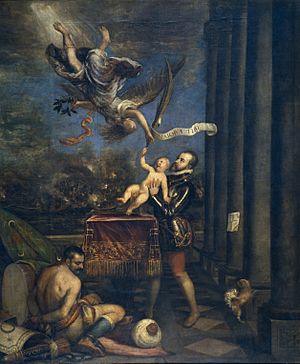
Early in his reign, Philip was worried about the growing power of the Ottoman Empire in the Mediterranean Sea. In 1558, Turkish forces attacked the Balearic Islands, causing a lot of damage.
In 1560, Philip formed a "Holy League" with other European powers. Their fleet was defeated by the Ottomans at the Battle of Djerba. However, in 1571, the Holy League, led by Philip's half-brother Don Juan of Austria, won a huge victory at the Battle of Lepanto. They destroyed most of the Ottoman fleet. This battle was a turning point and ended the major threat of Ottoman control in the Mediterranean. A peace treaty was signed with the Ottomans in 1585.
Challenges in the Netherlands
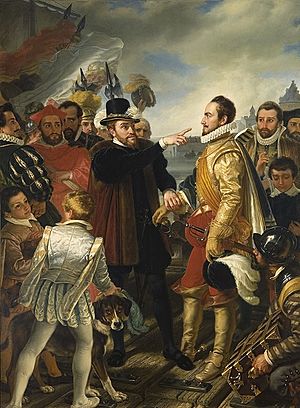
Philip's rule in the Seventeen Provinces (modern-day Netherlands, Belgium, and Luxembourg) faced many problems. He tried to control events from far away in Madrid, which upset the local people. There was also anger about his taxes and the harsh treatment of Protestants.
In 1566, Protestants started riots, destroying religious images. Philip sent the Duke of Alba with an army to stop the rebellion. Alba executed many leaders and caused massacres in several towns. This made the people even angrier.
Because Philip often couldn't pay his soldiers, they sometimes attacked cities, like the "Spanish Fury" in Antwerp in 1576. In 1581, the northern provinces declared their independence from Philip, forming the Dutch Republic. The war continued for many years, finally ending in 1648, long after Philip's death, when Spain recognized the Dutch Republic as independent.
Relations with England
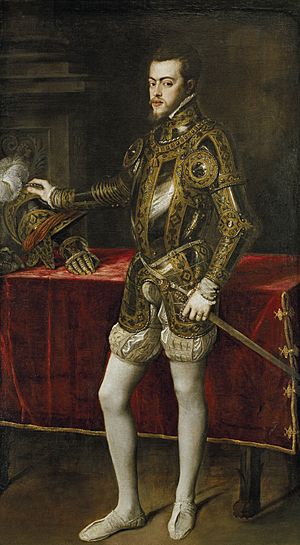
Philip's father arranged his marriage to Queen Mary I of England in 1554. This marriage made Philip King of England and Ireland alongside Mary. They appeared together on coins and official documents. However, they had no children, and Mary died in 1558. This meant Philip lost his claim to the English throne.
After Mary's death, her half-sister Elizabeth I became queen. Philip wanted to keep ties with England and even proposed marriage to Elizabeth. But Elizabeth was Protestant, and Philip was a strong Catholic. Eventually, England allied with the Protestant rebels in the Netherlands. English ships also began attacking Spanish trade ships.
In 1587, Elizabeth I executed Mary, Queen of Scots, a Catholic who many believed should be queen of England. This ended Philip's hopes of putting a Catholic on the English throne. He then decided to invade England.
In 1588, Philip sent a huge fleet, the Spanish Armada, to invade England. However, the plan faced many delays and communication problems. A big storm hit the English Channel, damaging many Spanish ships. The English navy also fought bravely. The Armada was forced to retreat, and many ships were destroyed by the harsh weather. This defeat was a major blow to Philip's plans.
Despite the Armada's failure, the war between England and Spain continued for many years. It didn't end until both Philip II (who died in 1598) and Elizabeth I (who died in 1603) were gone.
King of Portugal

In 1578, the young King Sebastian of Portugal died without children. This led to a crisis over who would be the next king. Philip II claimed the throne because his mother was a Portuguese princess.
Many people in Portugal supported António, Prior of Crato, but Philip's army marched into Portugal. They defeated António's troops at the Battle of Alcântara. Philip then entered Lisbon and took control. In 1581, Philip II of Spain was crowned Philip I of Portugal. This united the Spanish and Portuguese empires under one ruler for nearly 60 years. This gave Philip control over the vast Portuguese empire as well.
Philip allowed Portugal to keep its own laws, money, and government. He also gave important jobs to Portuguese nobles in his court.
Death and Legacy
Philip II died at El Escorial on September 13, 1598, from cancer. His 20-year-old son, Philip III, became the next king.
Under Philip II, Spain reached its greatest power. However, even with all the gold and silver from the Americas, he couldn't stop Protestantism or defeat the Dutch rebellion. He was a very religious Catholic. He once said he would rather lose everything than allow any harm to his religion.
He made the Inquisition very strict. Students couldn't study outside Spain, and books printed by Spaniards abroad were banned. This helped keep Spain Catholic and avoid the religious wars that tore apart other European countries.
Historians have different views of Philip II. Some see him as a great, pious king. Others see him as a harsh and controlling ruler. This is partly because Philip didn't allow biographies of himself to be published while he was alive. Also, his former secretary, Antonio Perez, spread many false stories about him.
Despite the different opinions, Philip II achieved a lot. He ended French power in Italy and made the Habsburg family very strong in Europe. He gained control of the Portuguese kingdom and its empire. He managed Spain's overseas empire and fought off the major threat from the Ottoman navy.
Family
Philip was married four times and had children with three of his wives.
-
Queen Mary Tudor of England by Antonis Mor
-
Queen Elisabeth of Valois by Juan Pantoja de la Cruz
-
Queen Anna of Austria by Sofonisba Anguissola
First Wife: Maria Manuela of Portugal
Philip's first wife was his cousin, Maria Manuela, Princess of Portugal. They married in 1543. They had one son:
- Carlos, Prince of Asturias (1545–1568). Maria died four days after Carlos was born. Carlos died unmarried at age 23.
Second Wife: Mary I of England
Philip's second wife was Queen Mary I of England. They married in 1554. This marriage was for political reasons. Philip became King of England and Ireland through this marriage. They had no children, and Mary died in 1558.
Third Wife: Elisabeth of Valois
Philip's third wife was Elisabeth of Valois, daughter of the French king. They married in 1559. They had five daughters, but only two survived:
- Isabella Clara Eugenia (1566–1633).
- Catherine Michaela (1567–1597).
Elisabeth died in 1568 after losing her last child.
Fourth Wife: Anna of Austria
Philip's fourth and final wife was his niece, Anna of Austria. They married in 1570. This was a happy marriage for both of them. They had five children, but only one survived to adulthood:
- Philip III of Spain (1578–1621).
Anna died in 1580.
-
Philip and his niece Anna banqueting with family and courtiers, by Alonso Sánchez Coello
Images for kids
-
Philip II wearing the Order of the Garter by Jooris van der Straeten, around 1554.
-
A marble bust of Philip II of Spain by Pompeo Leoni, found at the Metropolitan Museum of Art.
-
Portrait of Philip II as King of Portugal by Sánchez Coello, around 1580.
See also
 In Spanish: Felipe II de España para niños
In Spanish: Felipe II de España para niños
- Descendants of Isabella I of Castile and Ferdinand II of Aragon
- The empire on which the sun never sets
- List of Spanish monarchs
- Royal Armoury of Madrid
- Ruy Gómez de Silva, 1st Prince of Éboli


















